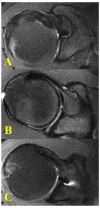Coracoid Impingement and Morphology Is Associated with Fatty Infiltration and Rotator Cuff Tears
- PMID: 35566785
- PMCID: PMC9100979
- DOI: 10.3390/jcm11092661
Coracoid Impingement and Morphology Is Associated with Fatty Infiltration and Rotator Cuff Tears
Abstract
This study describes measurements between the coracoid, glenoid, and humerus; characterizes coracoid shape, rotator cuff fatty infiltration, and quantitatively evaluates coracoid impingement and its association with anterosuperior rotator cuff tears (ASCT). 193 shoulder magnetic resonance imaging (MRI) scans demonstrating: rotator cuff tear; isolated tear of the supraspinatus; tear of supraspinatus and subscapularis, were included. MRI measurements included coracohumeral interval (CHI), coracoid overlap (CO), coracoid recess (CR), coracoglenoid angle (CGA), and coracoglenoid interval (CGI) on axial slices; acromiohumeral interval (AHI) on coronal slices; and coracohumeral interval (CHI) and coracoacromial ligament (CAL) thickness on sagittal slices. The coracoid shape was classified as flat, curved, or hooked. An Independent T-test was used to compare the MRI measurements and the different rotator cuff tear groups. In 79% of the patients with ASCT tears, the coracoid was curved. Axial CHI, CGA, sagittal CHI, and AHI were decreased in ASCT when compared to no tears and isolated supraspinatus tears (p < 0.05). CO was increased in ASCT compared to no tears and isolated supraspinatus tears (p < 0.05). Patients with an ASCT had a significantly increased subscapularis and supraspinatus Goutallier fatty infiltration score when compared to no tear and isolated supraspinatus tears (p < 0.05). These quantitative measurements may be useful in identifying patients at risk for ASCT. Level of Evidence III.
Keywords: anterosuperior cuff tear; coracoid impingement; coracoid morphology; magnetic resonance imaging; rotator cuff fatty infiltration; supraspinatus tear.
Conflict of interest statement
S.F.E.-A.III and A.G. have industrial affiliations, however, there are no conflicts of interest with the work presented in this manuscript. Thus, S.F.E.-A.III and A.G. declare no conflicts of interest. Other authors declare no conflicts of interest.
Figures







Similar articles
-
Relationship between Radiological Measurement of Subcoracoid Impingement and Subscapularis Tendon Lesions.Clin Orthop Surg. 2022 Sep;14(3):441-449. doi: 10.4055/cios21261. Epub 2022 Jul 21. Clin Orthop Surg. 2022. PMID: 36061841 Free PMC article.
-
Clinico-Radiological Correlation of Subcoracoid Impingement with Reduced Coracohumeral Interval and its Relation to Subscapularis Tears in Indian Patients.J Clin Diagn Res. 2016 Sep;10(9):RC17-RC20. doi: 10.7860/JCDR/2016/23344.8553. Epub 2016 Sep 1. J Clin Diagn Res. 2016. PMID: 27790534 Free PMC article.
-
Association of Coracoacromial Ligament Degeneration With Rotator Cuff Tear Patterns and Retear Rate.Orthop J Sports Med. 2023 Jun 7;11(6):23259671231175873. doi: 10.1177/23259671231175873. eCollection 2023 Jun. Orthop J Sports Med. 2023. PMID: 37347016 Free PMC article.
-
Multi-modal imaging of the subscapularis muscle.Insights Imaging. 2016 Dec;7(6):779-791. doi: 10.1007/s13244-016-0526-1. Epub 2016 Oct 17. Insights Imaging. 2016. PMID: 27752837 Free PMC article. Review.
-
[Arthroscopic superior capsule reconstruction using a 6 mm thick acellular dermal allograft for irreparable posterosuperior rotator cuff tears].Oper Orthop Traumatol. 2022 Feb;34(1):13-20. doi: 10.1007/s00064-021-00758-z. Epub 2022 Jan 16. Oper Orthop Traumatol. 2022. PMID: 35037093 Review. German.
Cited by
-
Analysis of the therapeutic efficacy of arthroscopic repair of the subscapularis tendon combined with coracoplasty.Sci Rep. 2025 Jan 10;15(1):1563. doi: 10.1038/s41598-025-85925-z. Sci Rep. 2025. PMID: 39794436 Free PMC article.
-
Three-dimensional computerized tomography reconstruction-based morphologic assessment of the coracoid process in an Asian population: Clinical implications for shoulder surgery.J Exp Orthop. 2024 Dec 15;11(4):e70109. doi: 10.1002/jeo2.70109. eCollection 2024 Oct. J Exp Orthop. 2024. PMID: 39678020 Free PMC article.
References
-
- Goldthwait J. An anatomic and mechanical study of the shoulder joint, explaining many of the cases of painful shoulder, many of the recurrent dislocations and many of the cases of brachial neuralgias or neuritis. J. Bone Jt. Surg. 1909;6:579–606.
Grants and funding
LinkOut - more resources
Full Text Sources
Research Materials

